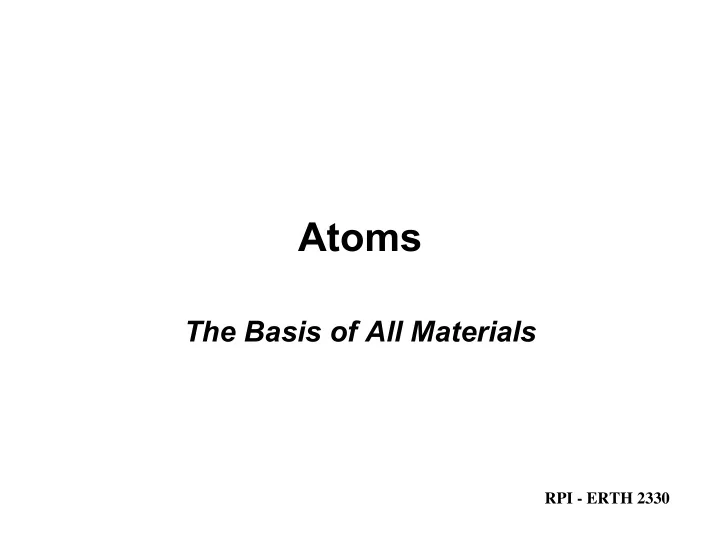

Atoms The Basis of All Materials RPI - ERTH 2330
The Atom • Neutron - neutral particle • Proton - positively charged particle • Electron - negatively charged particle E.B. Watson
Our story begins with light… Visible light – part of the EM spectrum Longer � Higher f v = � f, and v = 299,792,458 m / s (~3 E 8) in a vacuum � is length of a cycle in m, f is Hz (cycles per second)
Wave Terms FREQUENCY (f) number of cycles per unit time [units = Hertz (Hz)] 1 Hz = 1 cycle/s T = 1/f; f = 1/ T ; T f = 1
Refraction – producing constituent wavelengths Dispersion High f – more “bending” in prism
Refraction Waves are bent as the move through materials with different wave propagating properties E.B. Watson
The spectrum of the hydrogen atom E.B. Watson
Violet 1 7.3E14 Hz Violet 2 6.9E14 Hz Green 6.2E14 Hz Red 4.6E14 Hz What are the wavelengths (v=c)? � = v / f
Photo-Electric Effect Incident light causes movement of charge. Electrons move from the surface of the negatively-charged metal plate The intensity of the light determines how many electrons are produced, but not their kinetic energy. Wavelength changes kinetic energy
PHOTONS Small packets, or quanta, possessing specific amounts of energy. An incident photon is either totally absorbed by "target" matter or not absorbed at all* The energy of the photons in a monochromatic beam of light E = h f h is (Planck’s constant 6.626 E -34 Js) *Quantization of photons is like counting children - you can’t have a partial child
Energy transitions in Hydrogen E photon = E H - E L = h f
Balmer relationships Hydrogen spectra Line n Violet 6 Violet 5 Blue-green 4 Red 3 Any hot gas at low pressure will produce a line spectrum, although the spectra of other gases are more complex than that of hydrogen.
Bohr model - a "solar-system" model. assumptions: • an electron is in specific "allowed" orbits • the allowed orbits are described by m v r = n h / 2 � Planck’s const. Angular momentum F = m v 2 / r and F = k q 1 q 2 / r 2 Bohr saw this as charged particles on circular path set the forces equal
Bohr specific radii for electrons E.B. Watson j k l
It requires energy to remove electrons Energy increases with orbital distance. Lowest energy configuration – ground state Energy level at Energy level at ground state quantum number Quantum number
You can use this to determine changes in the amount of energy Describes the change in energy of an electron moved from 1st orbital (the ground state in H) to the n orbital
E.B. Watson
Electrons are attracted to the protons in the nucleus. Great, how big is the nucleus? E.B. Watson
E.B. Watson E.B. Watson
Elements differ from one another by the number of protons they contain (Z) Hydrogen (H) – 1 proton Helium (He) – 2 protons Sodium (Na) – 11 protons Francium (Fr) – 87 protons A neutral atom will have as many electrons as protons. Many atoms for each element will have the same number of neutrons as protons Elements of the same Z that differ in the number of neutrons are isotopes.
Atoms Mass Charge Electron 9.109 E -31 kg (-1) 1.602 E -19 coul. Neutrons 1.673 E -27 kg (0) None Proton 1.673 E -27 kg (+1) 1.602 E -19 coul. Z = number of protons N = number of neutrons A = atomic mass number (N + Z) Element = unique Z Isotope = unique Z, different N What happens to A? 14 C
Isotope Same Z, different N Carbon (C ) Z = 6 Carbon-12 12 C 6 protons, 6 neutrons 98.89% Carbon-13 13 C 6 protons, 7 neutrons 1.11% Carbon-14 14 C 6 protons, 8 neutrons trace Atomic mass units (u) Every isotope is scaled to 12 C (12.000 u)
The total mass (“ atomic weight” ) of any element is the sum of the weighted mass of its isotopes. For example, Oxygen has three isotopes mass (rel 12 C) Abundance 16 O 15.99491 99.759% 17 O 16.99914 0.037% 18 O 17.00016 0.204% (15.994191 x 0.99759) + (16.99914 x 0.00037) + (17.00016 x 0.00204) = 15.9994 u
• The interactions of electromagnetic radiation and electrons reveal the energy structure of the atoms • The interaction of charged nuclei reveal the size of atomic nuclei • The number of protons(+) determines the element’s identity • It also determines the number of electrons (-) • The number of electrons controls the behavior of the atom • The number of neutrons may vary - isotopes • Atomic mass is normalized to 12C • Atomic mass for an element is a function of isotope abundance and mass.
Recommend
More recommend